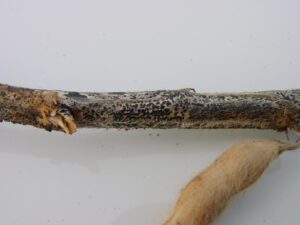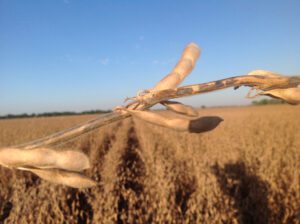Anthracnose in soybeans is a stem disease that occurs during wet, warm, and humid conditions. Caused by the fungus Colletotrichum truncatum, anthracnose symptoms usually are not seen until plants reach maturity in the season. While this disease typically has minimal effects on yield, it can reduce yields, stands, and overall seed quality.
Anthracnose symptoms can be mistaken for pod and stem blight; however, the symptoms are different, and both diseases may be present on the same plants late in the season. The fungus produces crowded, black acervuli on infected tissues.
 Symptoms of Anthracnose
Symptoms of Anthracnose
The most common symptoms are seen late in the season as the plants approach maturity. Irregular brown spots will develop in a random pattern on stems and pods. Brown cankers on petioles can form and cause defoliation. Infected pods will have fewer or smaller seeds per pod. Injected leaves may develop brown veins and curl up.
In older soybean plants, the stems, pods, and leaves may be infected without showing symptoms until the weather is warm and moist or the plants reach maturity. Infected seeds may have no symptoms or develop brown or gray areas with black specks.
The fungus overwinters in infested crop debris and may have seed-borne tendencies.
When infected seeds are planted pre-emergence and post-emergence, damping off may occur. Sunken, dark brown lesions develop on the cotyledons of seedlings. Seedling lesions may expand to the stem and kill young plants.
 Yield Impacts
Yield Impacts
Under typical growing conditions, anthracnose is unlikely to cause significant yield reductions in the Midwestern U.S. Yield impacts in the southern U.S., however, are much more common.
Infected pods generally contribute more to yield loss than infected stems or petioles, as infected pods may produce small seeds or no seeds at all. In addition to direct yield loss from infected pods and seeds, harvest losses can occur if plants lodge.
Lodged soybean plants can reduce yield potential and increase harvest losses. Lodging late in the season may reduce harvest efficiency and increase harvest losses.
Disease Management
While not an operation-altering disease, farmers can take a few steps to help manage anthracnose in their fields. Rotating to a non-host crop is a proven strategy to reduce anthracnose inoculum in fields. As soybean residue breaks down over time, it deprives the pathogen of its survival host.
Fall or spring tillage can also help manage this disease. Tillage that buries or shreds crop residue, enhancing its breakdown in the soil, is beneficial in reducing anthracnose inoculum in prior fields of soybeans or other host crops.
Additionally, the use of fungicides can aid in disease reduction. Foliar fungicides applied between the R3 and R5 soybean growth stages can help suppress anthracnose and reduce seed infection. Apply seed treatment fungicides to seed planted from fields with high levels of anthracnose. In the southern U.S., foliar fungicide applications have been shown to be an effective way of reducing late-season anthracnose.
As a disease, anthracnose may not drastically impact yields. However, it can take over fields and reduce overall seed quality. By implementing strategies such as crop rotation, tillage, and targeted fungicide applications, farmers can mitigate the impacts of anthracnose and safeguard their soybean crops. Proactive management helps maintain yield potential and enhances overall crop health, keeping fields cleaner for the next growing season.
 Yield Impacts
Yield Impacts